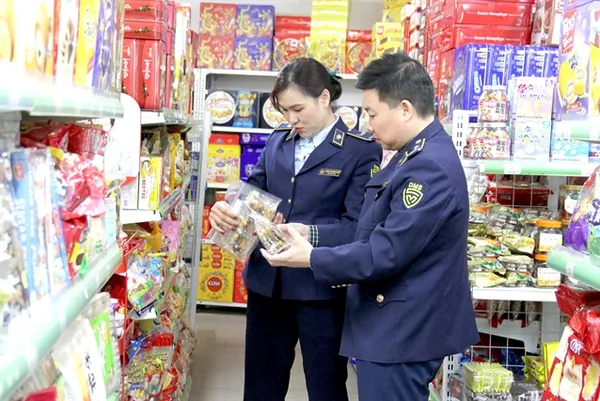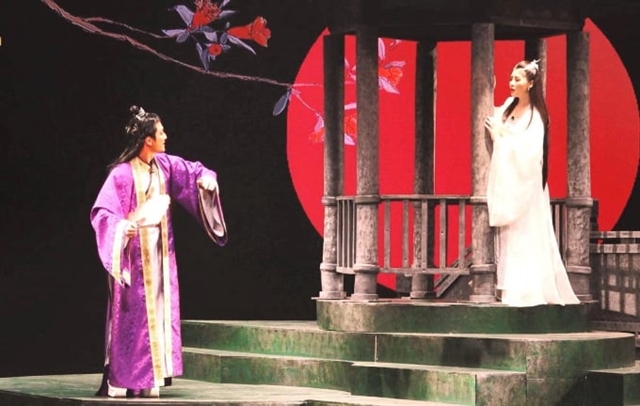 Life & Style
Life & Style


|
| The art programme Ký Ức Để Lại (Memories Left Behind) incorporates many modern, high-tech visual effects. — Photo courtesy of VTV |
HÀ NỘI — Amid the Fourth Industrial Revolution, traditional theatres have actively embraced technology to foster innovation – but there is still a lot of work to be done to truly realise its potential within the cultural industry, said experts.
According to artist Triệu Trung Kiên, director of the Việt Nam Cải Lương (Reformed Opera) Theatre, the stage's space and time used to be represented through a backdrop designed by a visual artist painted on fabric.
Today, with the use of LED screens and projectors, artists can design more realistic images, offering a wider variety of forms and dynamic visuals.
Several performances staged at the theatre since 2013, such as Chuyện Tình Khau Vai (Khau Vai Love Story) and Mai Hắc Đế, as well as more recent works like Nợ Nước Non (Debts to the Homeland) and Cánh Cửa Khép Hờ (The Slightly Ajar Door), have continued to incorporate this technology.
This type of technology and others like it have also been used to make stage performances more enchanting, creating fresh sensory experiences and a wider appeal for audiences.
For example, the Hà Nội Cải Lương Theatre has implemented a project where actors' performances are closely integrated with visuals, sometimes interacting with scenarios projected on screens. This approach has achieved an aesthetic effect similar to modern dance dramas and musicals.
In HCM City, several theatres have made significant strides in applying modern technology to create powerful visual effects and enhance the audience experience. For instance, in the play Âm Binh (The Spirit Soldiers) from the Young World Theatre, scene transitions are achieved using projections of sand paintings. Meanwhile, the play Cuộc Hành Trình Tìm Bức Chân Dung (The Journey to Find the Portrait) from the HCM City Drama Theatre uses LED screens, gauze screens and 4D effects to vividly recreate war scenes and natural environments.
The transition of performing arts from traditional theatre to digital platforms has also transformed accessibility. Many performances, such as Lôi Vũ, Lão Hà Tiện (The Miser) and Hamlet from the Việt Nam Drama Theatre, have been released on YouTube and Facebook, allowing audiences to enjoy theatrical productions regardless of their location. This change opens up new opportunities for audience engagement and diversifies forms of expression.
Online theatre, featuring livestreams of performances from the Trần Hữu Trang Theatre, Vietnam Drama Theatre and various independent artist groups, often attract hundreds of thousands of viewers.
The digitisation of performing arts also helps preserve traditional art forms. The development of high-quality video recording technology and online platforms allows plays, cải lương (reformed opera), tuồng (classical drama) or chèo (popular opera) to be easily digitised, stored and replayed. This ensures that these artistic expressions can be maintained and accessed by future generations.
Challenges

|
| The performance Thúy Kiều - Một Kiếp Đoạn Trường (Thúy Kiều - A Life of Suffering) by the Hà Nội Drama Theatre uses technology in its stage design. — Photo courtesy of the theatre |
Experts also noted that Vietnamese performing artists have been adopting Industry 4.0 technology in their work over the past few years; however, there are still many challenges that need to be addressed.
These include issues related to funding, training and access to the latest technology, which can hinder the full potential of digital integration in the performing arts.
Artist Lê Tuấn Cường, director of the Vietnam Chèo Theatre, said the sound and lighting equipment at the theatre on Kim Mã Street is over 10 years old and has not been updated, making it difficult to access new technology.
“There is a lack of modern technical lighting, and the sound quality has deteriorated significantly due to prolonged use, resulting in many damaged components and a lack of synchronisation. The effectiveness of the theatre's current performances is therefore quite limited,” he noted.
Many traditional theatres in several localities are facing similar challenges. Equipment is not updated promptly and often relies on approved funding. As a result, theatres sometimes have to make small-scale purchases, like power speakers, lights and decorations for immediate performances, leading to a lack of synchronisation and reduced effectiveness in their shows.
A common issue in traditional theatres today is that most sound and lighting experts were trained around 20 years ago, making it difficult for them to familiarise themselves with new technologies. This leads to ineffective operation of sound and lighting equipment.
Meanwhile, the high cost of purchasing equipment and numerous purchasing procedures create difficulties in investing in new technology. Some performances require multidimensional sound effects, electronic music or complex arrangements, which often necessitate renting equipment from outside sources, leading to increased costs and a lack of flexibility in staging. Artist Lê Tuấn Cường likened this situation to having a skilled chef but using spoiled ingredients, resulting in poor dishes.
The lack of collaboration between performing units, training institutions and management agencies has also created challenges in finding qualified personnel to meet high-tech demands.
Specialists noted that applying modern technology is essential, but to be effective, it is necessary to decisively address existing challenges. A harmonious combination of modern technology and traditional identity is a sustainable path for performing arts in the digital age. — VNS




